2-D Characteristics of Wave Deformation Due to Wave-Current Interactions with Density Currents in an Estuary
Abstract
1. Introduction
2. Numerical Model
2.1. Governing Equations
2.2. Advection-Diffusion Equations
2.3. Turbulence Model
2.3.1. Eddy Viscosity Model
2.3.2. Dynamic Eddy Viscosity Model
2.4. Non-Reflected Boundary
2.5. Numerical Water Basin Stability
2.6. Numerical Model Validation
2.6.1. Wave-Current Interaction
2.6.2. Salinity Advection
3. Numerical Results
3.1. Wave-Current Interactions without Density Current
3.1.1. Description of Numerical Water Basin and Incident Conditions
3.1.2. Distribution of Wave Heights
3.1.3. Characteristics of Turbulent Kinitic Energy (TKE)
3.1.4. Wave Energy Loss Characteristics
3.1.5. Wave Reflection Characteristics
3.1.6. Mean Wave Level Characteristics
3.2. Wave-Current Interactions with Density Current
3.2.1. Description of Numerical Water Basin and Incident Conditions
3.2.2. Density Current Formation Characteristics
3.2.3. Wave Height Variation
3.2.4. Vertical Distribution of TKE
4. Conclusions
- When the ratio (Vc/Ci) between current velocity and wave celerity increases, wave height decay increases. Wave reflection by currents forms a partial standing wave field.
- When the Vc/Ci velocity ratio increases, the overall mean phase-average TKE increases. At higher incident wave heights, wave steepness, and Ursell numbers larger increases occur near still-water levels. Longer incident periods lead to larger increases, except near the still-water level.
- As a result of turbulence caused by wave-current interactions, wave energy increases as the Vc/Ci increases. When the incident wave height is high, TKE increases and the wave energy decay rate decreases. Higher wave heights have higher wave energy, therefore the energy decay rate is relatively low.
- The rate of wave reflection due to currents becomes larger as the Vc/Ci increases. With longer wave periods, the exposure time in wave troughs, in which the wave orbital motion velocity and current velocity are opposite in direction, is longer, and thus the wave reflection rate is increased. As a result, reflection rates of up to 0.068 were found under the incident conditions applied in this study.
- The mean water level increases more due to wave-current interactions as the velocity ratio Vc/Ci increases, which further reduces wave energy.
- Various currents are generated depending on the density difference between two fluids.
- Wave height decay due to various current-wave interactions is highest in cases involving upper currents, in which strong interactions occur near still-water levels. Cases involving middle current and undercurrent feature less wave height decay than do cases with uniform-depth currents, which feature no density current.
- The mean phase-average TKE vertical distribution is broad near each type of current. Greater wave height decay values are accompanied by higher mean phase-average TKE.
Author Contributions
Funding
Conflicts of Interest
Appendix A. Fluid Density Equations
| ρ0 = 0.999842594 g/cm3 | a5 = 6.536332 × 10−12 | a10 = 5.38750 × 10−12 |
| a1 = 6.793952 × 10−5 | a6 = 8.244930 × 10−4 | a11 = 5.72466 × 10−6 |
| a2 = 9.095290 × 10−6 | a7 = 4.089900 × 10−6 | a12 = 1.02270 × 10−7 |
| a3 = 1.001685 × 10−7 | a8 = 7.643800 × 10−8 | a13 = 1.65460 × 10−9 |
| a4 = 1.120083 × 10−9 | a9 = 8.246700 × 10−10 | a14 = 4.83140 × 10−7 |
Appendix B. Kinematic Viscosity Coefficient Equations
| μ0 = 1.802863 × 10−2 g/cm·s | b2 = 1.31419 × 10−5 | b4 = 2.15123 × 10−5 |
| b1 = 6.108600 × 10−4 | b3 = 1.35576 × 10−7 | b5 = 3.59406 × 10−10 |
References
- Geyer, W.R.; MacCready, P. The estuarine circulation. Annu. Rev. Fluid Mech. 2014, 46, 175–197. [Google Scholar] [CrossRef]
- Bolaños, R.; Brown, J.M.; Souza, A.J. Wave–current interactions in a tide dominated estuary. Cont. Shelf Res. 2014, 87, 109–123. [Google Scholar] [CrossRef]
- Bates, C.C. Rational theory of delta formation. Bull. Am. Assoc. Pet. Geol. 1953, 37, 2119–2162. [Google Scholar]
- Boggs, S. Principles of Sedimentology and Stratigraphy, 2nd ed.; Prentice Hall: Englewood Cliffs, NJ, USA, 1995; p. 774. [Google Scholar]
- Kang, K.R.; Iorio, D.D. Depth- and current-induced effects on wave propagation into the Altamaha River Estuary, Georgia. Estuar. Coast. Shelf Sci. 2006, 66, 395–408. [Google Scholar] [CrossRef]
- Zippel, S.; Thomson, J. Surface wave breaking over sheared currents: Observations from the Mouth of the Columbia River. J. Geophys. Res. Ocean. 2017, 122, 3311–3328. [Google Scholar] [CrossRef]
- Tanaka, H.; Nagabayashi, H.; Yamauchi, K. Observation of wave set-up height in a river mouth. In Proceedings of the 27th International Conference on Coastal Engineering, Sydney, Australia, 16–21 July 2000; pp. 3458–3471. [Google Scholar]
- Nguyen, X.T.; Tanaka, H.; Nagabayashi, H. Wave setup at river and inlet entrances due to an extreme event. In Proceedings of the International Conference on Violent Flows, Fukuoka, Japan, 20–22 November 2007. [Google Scholar]
- Donnell, J.O. Observations of near-surface currents and hydrography in the Connecticut River plume with the surface current and density array. J. Geophys. Res. Ocean. 1997, 102, 25021–25033. [Google Scholar] [CrossRef]
- Smith, J.M.; Seabergh, W.C.; Harkins, G.S.; Briggs, M.J. Wave Breaking on a Current at an Idealized Inlet, Coastal Inlets Research Program, Inlet Laboratory Investigations; Technical Report CHL-98-31; US Army Engineer Waterways Experiment Station: Vicksburg, MS, USA, 1998. [Google Scholar]
- Ibrahim, Z.; Latiff, A.A.A.; Halim, A.H.A.; Bakar, N.A.; Subramaniam, S. Experimental studies on mixing salt wedge estuary. Malays. J. Civ. Eng. 2008, 20, 188–199. [Google Scholar]
- Shi, F.; Dalrymple, R.A.; Kirby, J.T.; Chen, Q.; Kennedy, A. A fully nonlinear Boussinesq model in generalized curvilinear coordinates. Coast. Eng. 2001, 42, 337–358. [Google Scholar] [CrossRef]
- de Brye, B.; de Brauwere, A.; Gourgue, O.; Kärnä, T.; Lambrechts, J.; Comblen, R.; Deleersnijder, E. A finite-element, multi-scale model of the Scheldt tributaries, River, Estuary and ROFI. Coast. Eng. 2010, 57, 850–863. [Google Scholar] [CrossRef]
- Pascolo, S.; Petti, M.; Bosa, S. Wave–Current Interaction: A 2DH Model for Turbulent Jet and Bottom-Friction Dissipation. Water 2018, 10, 392. [Google Scholar] [CrossRef]
- Sutherlanda, J.; Walstrab, D.J.R.; Cheshera, T.J.; van Rijn, L.C.; Southgate, H.N. Evaluation of coastal area modelling systems at an estuary mouth. Coast. Eng. 2004, 51, 119–142. [Google Scholar] [CrossRef]
- Lesser, G.R.; Roelvink, J.A.; van Kester, J.A.T.M.; Stelling, G.S. Development and validation of a three-dimensional morphological model. Coast. Eng. 2004, 51, 883–915. [Google Scholar] [CrossRef]
- Booij, N.; Ris, R.C.; Holthuijsen, L.H. A third-generation wave model for coastal regions, Part I, Model description and validation. J. Geophys. Res. 1999, 104, 7649–7666. [Google Scholar] [CrossRef]
- The WAMDI Group. The WAM model—A third generation ocean wave prediction model. J. Phys. Oceanogr. 1988, 18, 1775–1810. [Google Scholar] [CrossRef]
- Zhang, Q.-H.; Tan, F.; Han, T.; Wang, X.-Y.; Hou, Z.-Q.; Yang, H. Simulation of sorting sedimentation in the channel of Huanghua harbor by using 3d multi-sized sediment transport model of EFDC. In Proceedings of the 32nd International Conference on Coastal Engineering, Shanghai, China, 30 June–5 July 2010; pp. 1604–1614. [Google Scholar]
- Liang, B.; Zhao, H.; Li, H.; Wu, G. Numerical study of three-dimensional wave-induced longshore current’s effects on sediment spreading of the Huanghe River mouth. Acta Oceanol. Sin. 2012, 31, 129–138. [Google Scholar] [CrossRef]
- Baddour, R.E.; Song, S. On the interaction between waves and currents. Ocean Eng. 1990, 17, 1–21. [Google Scholar] [CrossRef]
- Peregrine, D.H. Interaction of Water Waves and Currents. Adv. Appl. Mech. 1976, 16, 9–117. [Google Scholar]
- Jonsson, I.G.; Skougaard, C.; Wang, J.D. Interaction between waves and currents. Coast. Eng. 1970, 1, 489–507. [Google Scholar]
- Wolf, J.; Prandle, D. Some observations of wave–current interaction. Coast. Eng. 1999, 37, 471–485. [Google Scholar] [CrossRef]
- Gonzalez, F.I. A case study of wave-current-bathymetry interactions at the Columbia River Entrance. J. Phys. Oceanogr. 1984, 14, 1065–1078. [Google Scholar] [CrossRef]
- Grant, W.D.; Madsen, O.S. Combined wave and current interaction with a rough bottom. J. Geophys. Res. Ocean. 1979, 84, 1797–1808. [Google Scholar] [CrossRef]
- Fredsøe, J. Turbulent boundary layer in wave-current motion. J. Hydraul. Eng. 1984, 110, 1103–1120. [Google Scholar] [CrossRef]
- Christoffersen, J.B.; Jonsson, I.G. Bed friction and dissipation in a combined current and wave motion. Ocean Eng. 1985, 12, 387–423. [Google Scholar] [CrossRef]
- Soulsby, R.L.; Hamm, L.; Klopman, G.; Myrhaug, D.; Simons, R.R.; Thomas, G.P. Wave–current interaction within and outside the bottom boundary layer. Coast. Eng. 1993, 21, 41–69. [Google Scholar] [CrossRef]
- Jonsson, I.G. Wave–Current Interactions; The Sea; Le Méhauté, B., Hanes, D.M., Eds.; Wiley: New York, NY, USA, 1990; Volume 9, pp. 65–120. [Google Scholar]
- Umeyama, M. Reynolds stresses and velocity distributions in a wave-current coexisting environment. J. Waterw. Portcoast. Ocean Eng. 2005, 131, 203–212. [Google Scholar] [CrossRef]
- Lee, W.D.; Mizutani, N.; Hur, D.S. Experimental analysis of wave deformation and bottom flow under wave-current interaction in the river mouth. Ocean Eng. 2017, 140, 169–182. [Google Scholar] [CrossRef]
- Umeyama, M. Coupled PIV and PTV measurements of particle velocities and trajectories for surface waves following a steady current. J. Waterw. Portcoast. Ocean Eng. 2010, 137, 85–94. [Google Scholar] [CrossRef]
- Chen, Y.Y.; Hsu, H.C.; Hwung, H.H. Particle trajectories beneath wave-current interaction in a two-dimensional field. Nonlinear Process. Geophys. 2012, 19, 185–197. [Google Scholar] [CrossRef]
- Fernando, P.C.; Guo, J.; Lin, P. Wave-current interaction at an angle 1: Experiment. J. Hydraul. Res. 2011, 49, 424–436. [Google Scholar] [CrossRef]
- Lim, K.Y.; Madsen, O.S. An experimental study on near-orthogonal wave–current interaction over smooth and uniform fixed roughness beds. Coast. Eng. 2016, 116, 258–274. [Google Scholar] [CrossRef]
- Longuet-Higgins, M.S.; Stewart, R.W. The changes in amplitudes of short gravity waves on steady non-uniform currents. J. Fluid Mech. 1961, 10, 529–549. [Google Scholar] [CrossRef]
- Dingemans, M.W. Water Wave Propagation over Uneven Bottoms; Advanced Series on Ocean Engineering 13; World Scientific: London, UK, 1997; p. 1016. [Google Scholar]
- Lee, K.H.; Mizutani, N.; Komatsu, K.; Hur, D.S. Experimental study on wave-current interaction. In Proceedings of the 16th International Offshore and Polar Engineering Conference, San Francisco, CA, USA, 28 May–2 June 2006; pp. 600–606. [Google Scholar]
- Rey, V.; Charland, J.; Touboul, J. Wave–current interaction in the presence of a three-dimensional bathymetry: Deep water wave focusing in opposing current conditions. Phys. Fluids 2014, 26, 096601. [Google Scholar] [CrossRef]
- Drevard, D.; Rey, V.; Fraunie, P. Partially standing wave measurement in the presence of steady current by use of coincident velocity and/or pressure data. Coast. Eng. 2009, 56, 992–1001. [Google Scholar] [CrossRef]
- Mizutani, N.; Lee, K.H.; Komatsu, K.; Hur, D.S. Fundamental study on wave-current interaction. Proc. Coast. Eng. Conf. Jpn. Soc. Civ. Eng. 2005, 21, 307–312. (In Japanese) [Google Scholar]
- Mizutani, N.; Hur, D.S.; Maeda, Y. Numerical analysis of nonlinear wave-current interaction in side harbor. Proc. Coast. Eng. Conf. Jpn. Soc. Civ. Eng. 2002, 49, 51–55. (In Japanese) [Google Scholar]
- Lee, K.H.; Ohori, F.; Mizutani, N.; Kuwabara, S. A study on interactions between effluent currents and incoming waves near an estuary. Annu. J. Civ. Eng. Ocean. Soc. Civ. Eng. 2008, 24, 897–902. (In Japanese) [Google Scholar]
- Lee, W.D.; Mizutani, N.; Hur, D.S. Effect of crossing angle on interaction between wave and current in the river mouth. J. Jpn. Soc. Civ. Eng. Ser. B3 (Ocean Eng.) 2011, 67, 256–261. (In Japanese) [Google Scholar]
- Liu, Z.; Lin, Z.; Tao, L.; Lan, J. Nonlinear wave–current interaction in water of finite depth. J. Waterw. Portcoast. Ocean Eng. 2016, 142, 04016009. [Google Scholar] [CrossRef]
- Lee, W.D.; Jeong, Y.H.; Jeon, H.S. Groundwater flow analysis in a coastal aquifer with the coexistence of seawater and freshwater by using a non-hydrostatic pressure model. J. Coast. Res. 2019, 91, 121–125. [Google Scholar] [CrossRef]
- Lee, W.D.; Yoo, Y.J.; Jeong, Y.M.; Hur, D.S. Experimental and numerical analysis on hydraulic characteristics of coastal aquifers with seawall. Water 2019, 11, 2343. [Google Scholar] [CrossRef]
- Hur, D.S.; Lee, W.D.; Cho, W.C. Three-dimensional flow characteristics around permeable submerged breakwaters with open inlet. Ocean Eng. 2012, 44, 100–116. [Google Scholar] [CrossRef]
- Hur, D.S.; Lee, W.D.; Cho, W.C. Characteristics of wave run-up height on a sandy beach behind dual-submerged breakwaters. Ocean Eng. 2012, 45, 38–55. [Google Scholar] [CrossRef]
- Hur, D.S.; Lee, W.D.; Cho, W.C.; Jeong, Y.H.; Jeong, Y.M. Rip current reduction at the open inlet between double submerged breakwaters by installing a drainage channel. Ocean Eng. 2019, 193, 106580. [Google Scholar] [CrossRef]
- Hur, D.S.; Mizutani, N. Numerical estimation of the wave forces acting on a three-dimensional body on submerged breakwater. Coast. Eng. 2003, 47, 329–345. [Google Scholar] [CrossRef]
- Hur, D.S.; Mizutani, N.; Kim, D.S. Direct 3-d numerical simulation of wave forces on asymmetric structures. Coast. Eng. 2004, 51, 407–420. [Google Scholar] [CrossRef]
- Smagorinsky, J. General circulation experiments with the primitive equation. Mon. Weather Rev. 1963, 91, 99–164. [Google Scholar] [CrossRef]
- Hur, D.S.; Lee, K.H.; Yeom, G.S. The phase difference effects on 3-d structure of wave pressure acting on a composite breakwater. Ocean Eng. 2008, 35, 1826–1841. [Google Scholar] [CrossRef]
- Sakakiyama, T.; Kajima, R. Numerical simulation of nonlinear wave interacting with permeable breakwater. In Proceedings of the 23rd International Conference on Coastal Engineering, Venice, Italy, 4–9 October 1992; pp. 1517–1530. [Google Scholar]
- Ergun, S. Fluid flow through packed columns. Chem. Eng. 1952, 48, 89–94. [Google Scholar]
- van Gent, M.R.A. Wave Interaction with Permeable Coastal Structures. Ph.D. Thesis, Delft University, Delft, The Netherlands, 1995; p. 175. [Google Scholar]
- Liu, S.; Masliyah, J.H. Non-linear flows porous media. J. Non-Newton. Fluid Mech. 1999, 86, 229–252. [Google Scholar] [CrossRef]
- Gill, A.E. Atmosphere-Ocean Dynamics; Academic Press: New York, NY, USA, 1982; p. 662. [Google Scholar]
- Riley, J.P.; Skirrow, G. Chemical Oceanography 3; Academic Press: London, UK, 1965. [Google Scholar]
- Germano, M.; Piomelli, U.; Moin, P.; Cabot, W.H. A dynamic subgrid-scale eddy viscosity model. Phys. Fluids 1991, 3, 1760–1765. [Google Scholar] [CrossRef]
- Lilly, D.K. A proposed modification of the Germano subgrid-scale closure method. Phys. Fluids 1991, 4, 633–635. [Google Scholar] [CrossRef]
- Brorsen, M.; Larsen, J. Source generation of nonlinear gravity wave with boundary integral equation method. Coast. Eng. 1987, 11, 93–113. [Google Scholar] [CrossRef]
- Ohyama, T.; Nadaoka, K. Modeling the transformation of nonlinear waves passing over a submerged dike. In Proceedings of the 23rd International Conference on Coastal Engineering, Venice, Italy, 4–9 October 1992; pp. 526–539. [Google Scholar]
- Hirt, C.W.; Nichols, B.D. Volume of fluid (VOF) method for the dynamics of free boundaries. J. Comput. Phys. 1981, 39, 201–225. [Google Scholar] [CrossRef]
- Mellor, G.L.; Yamada, M. Development of a turbulence closure model for geophysical fluid problems. Rev. Geophys. 1982, 20, 851–875. [Google Scholar] [CrossRef]
- Gregg, M.C.; D’Asaro, E.A.; Shay, T.J.; Larson, N. Observations of persistent mixing and near-inertial internal waves. J. Phys. Oceanogr. 1986, 16, 856–885. [Google Scholar] [CrossRef]
- Peters, F.; Gregg, M.C.; Toole, J.M. On the parameterization of equatorial turbulence. J. Geophys. Res. 1988, 93, 1199–1218. [Google Scholar] [CrossRef]
- Hinatsu, M. Numerical simulation of unsteady viscous nonlinear waves using moving grid system fitted on a free surface. J. Kansai Soc. Nav. Archit. 1992, 217, 1–11. [Google Scholar]
- Petit, H.A.H.; Tonjes, P.; ven Gent, M.R.A.; van den Bosch, P. Numerical simulation and validation of plunging breakers using a 2D Navier–Stokes model. In Proceedings of the 24th International Conference on Coastal Engineering, Kobe, Japan, 23–28 October 1994; pp. 511–524. [Google Scholar]
- Iwasaki, T.; Sato, M. Energy damping of wave propagating against currents (2). Proc. Coast. Eng. Conf. Jpn. Soc. Civ. Eng. 1971, 18, 55–59. (In Japanese) [Google Scholar]
- Huppert, H.E.; Simpson, J.E. The slumping of gravity currents. J. Fluid Mech. 1980, 99, 785–799. [Google Scholar] [CrossRef]
- Sakai, S.; Saeki, H. Effects of opposing current on wave transformation on sloping sea bed. In Proceedings of the 19th International Conference on Coastal Engineering, Houston, TX, USA, 3–7 September 1984; pp. 1219–1232. [Google Scholar]
- Christensen, E.D. Large eddy simulation of spilling and plunging breakers. Coast. Eng. 2006, 53, 463–485. [Google Scholar] [CrossRef]
- Healy, J.J. Wave damping effect of beaches. In Proceedings, Minnesota International Hydraulic; St. Anthony Falls Hydraulic Laboratory: Minneapolis, MN, USA, 1952; pp. 213–220. [Google Scholar]
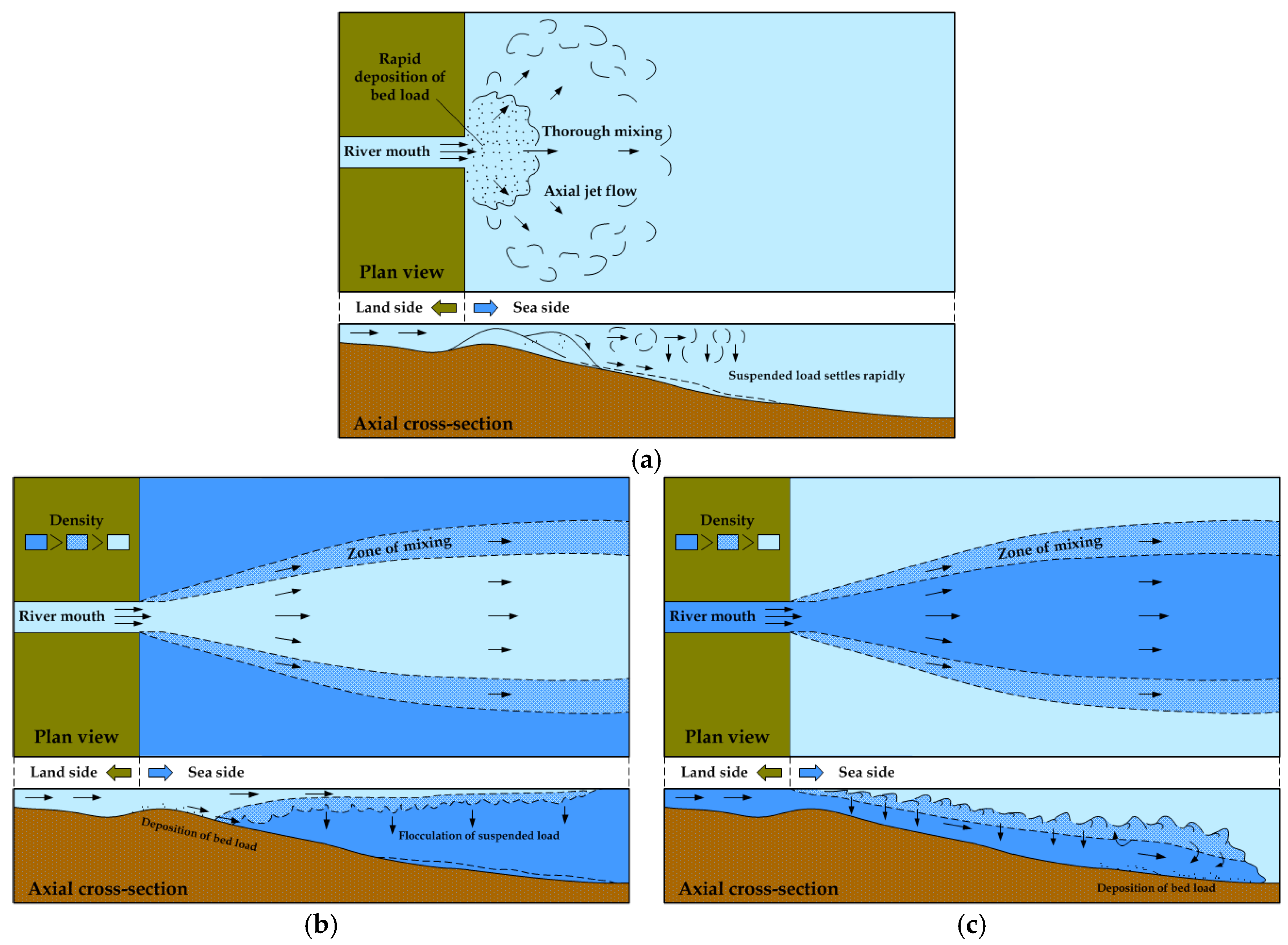
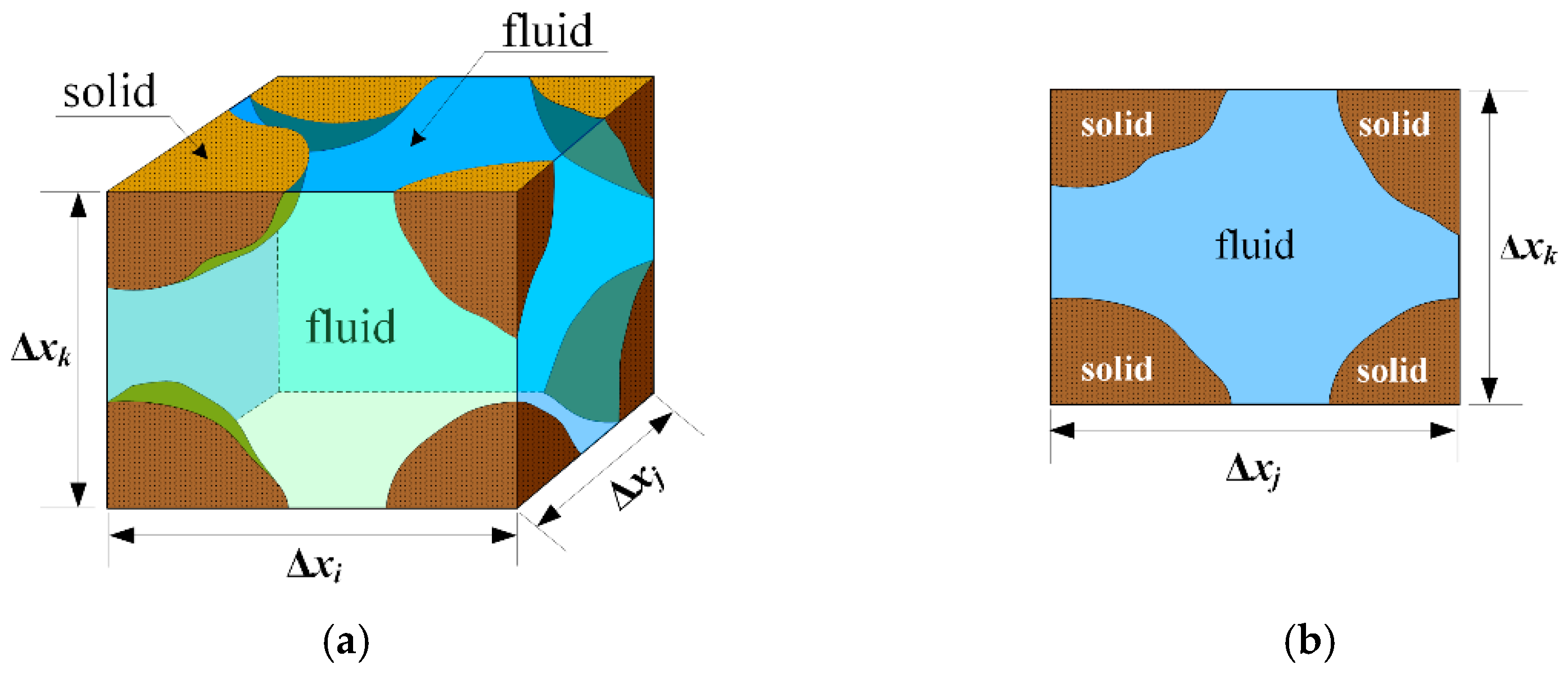
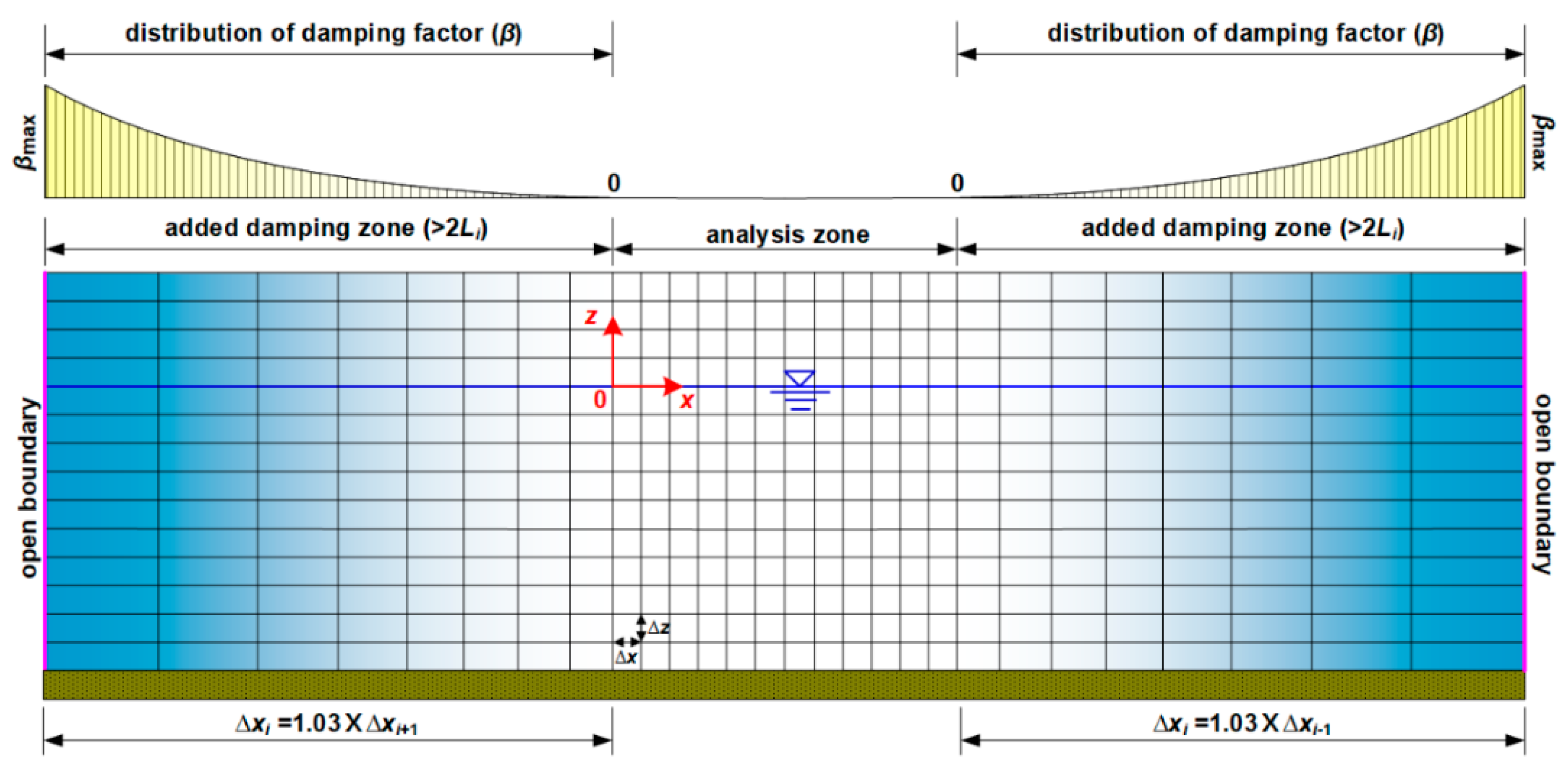
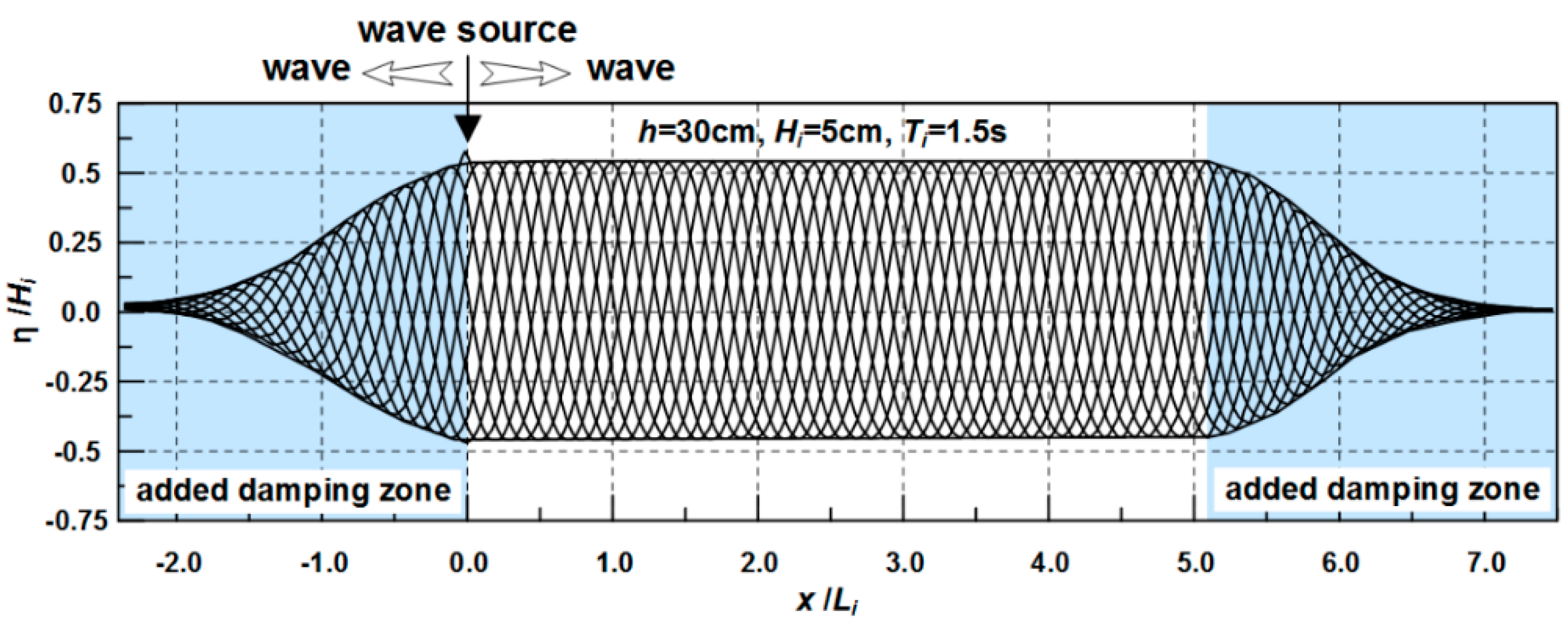

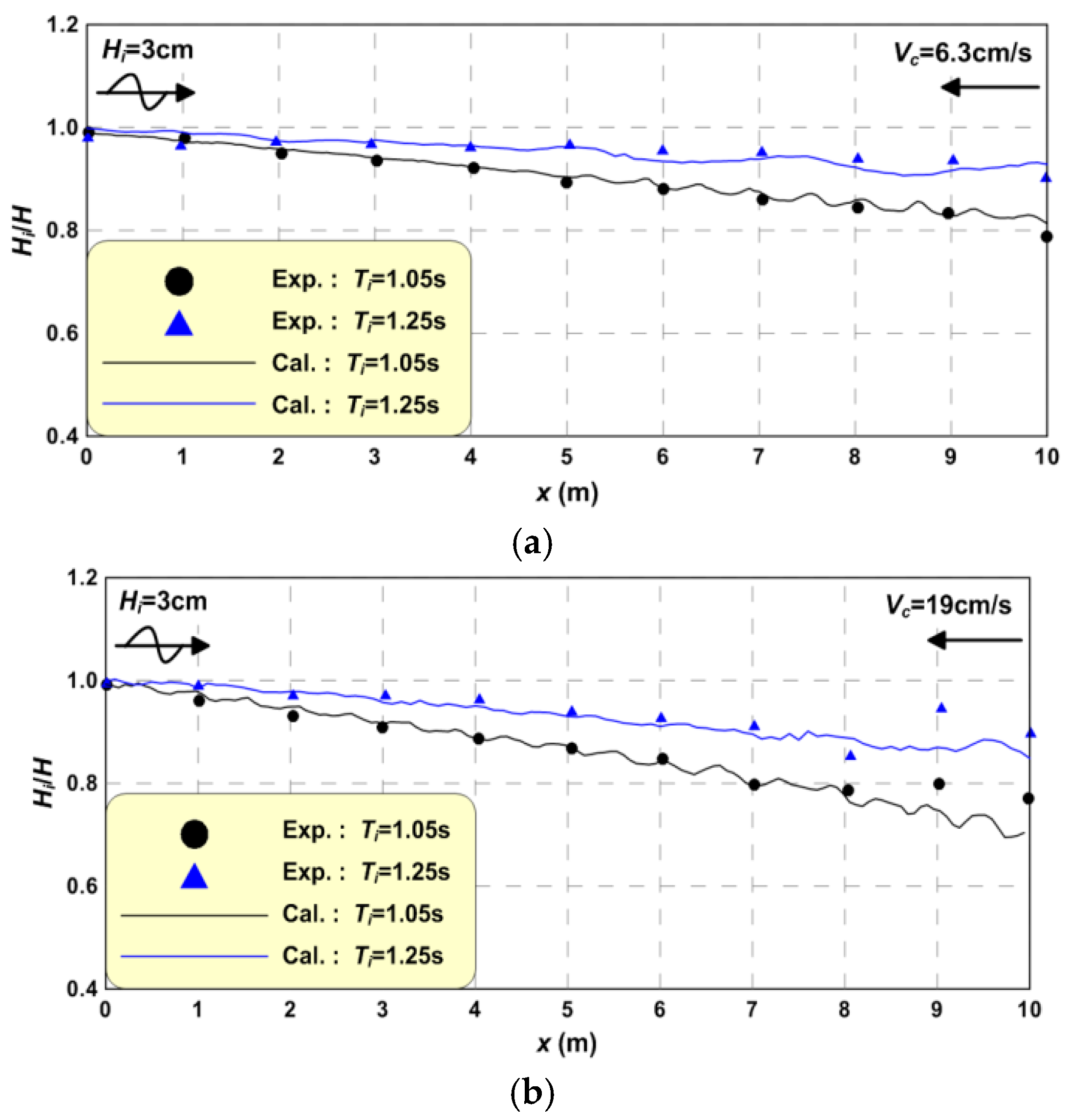
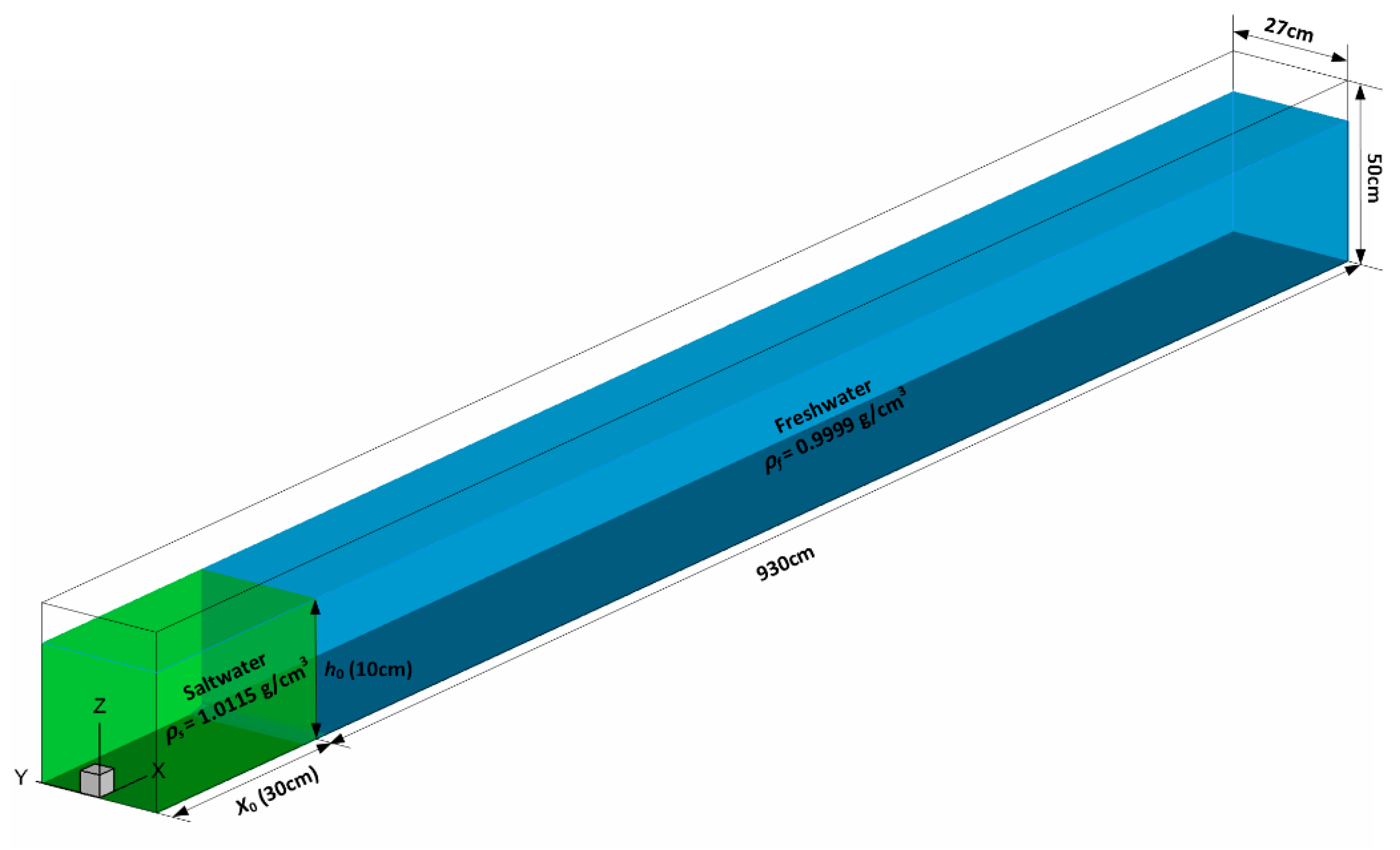
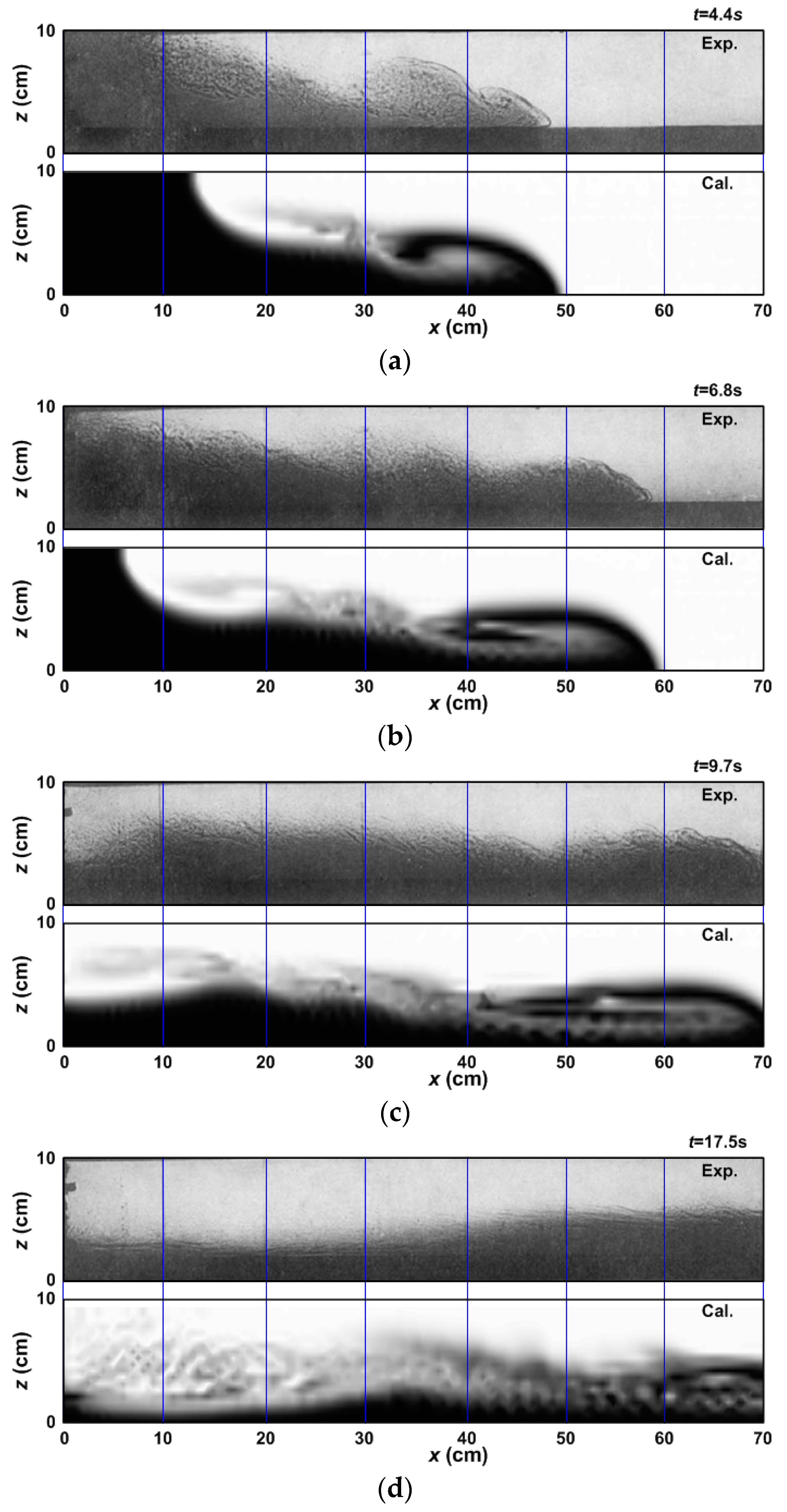
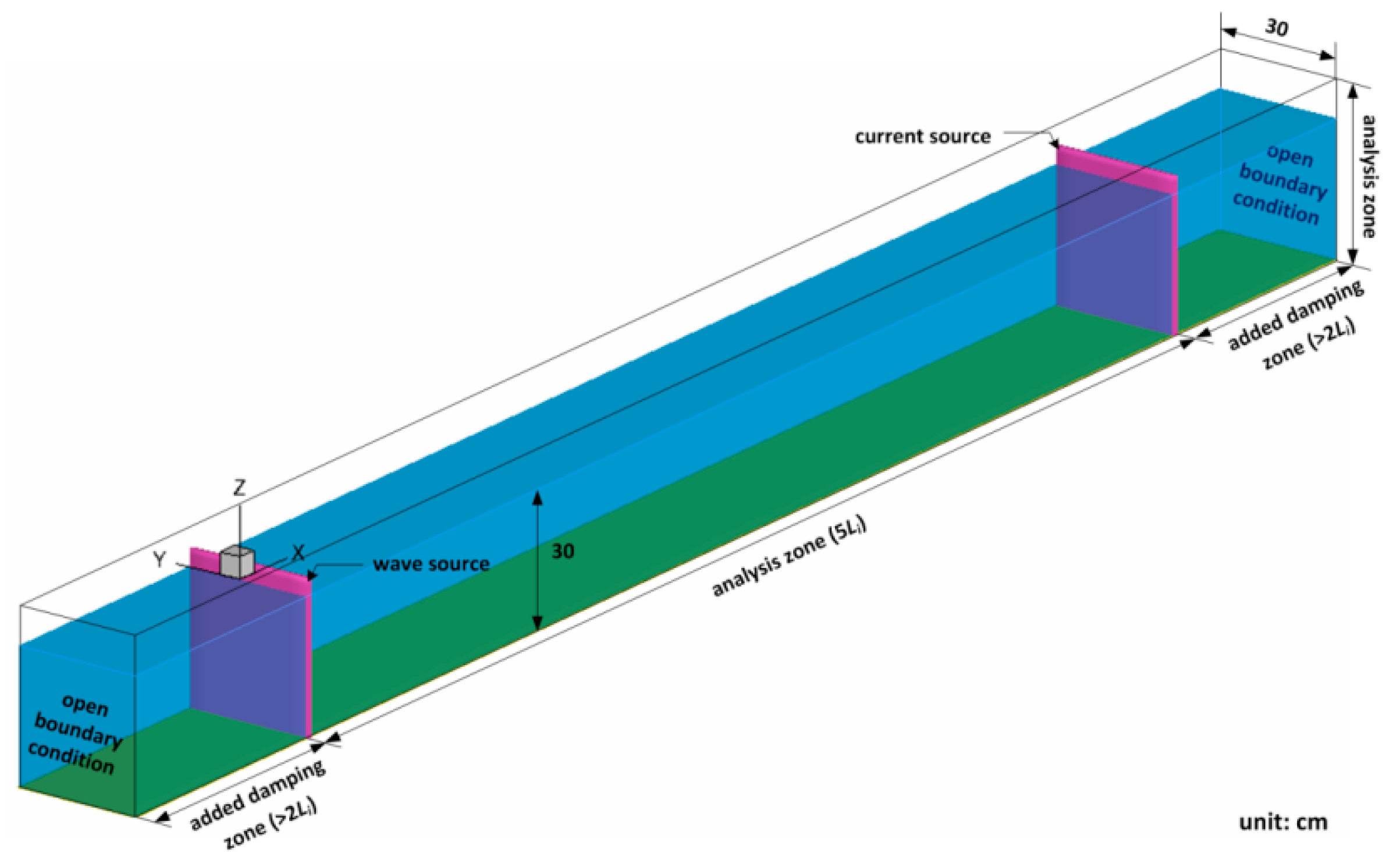
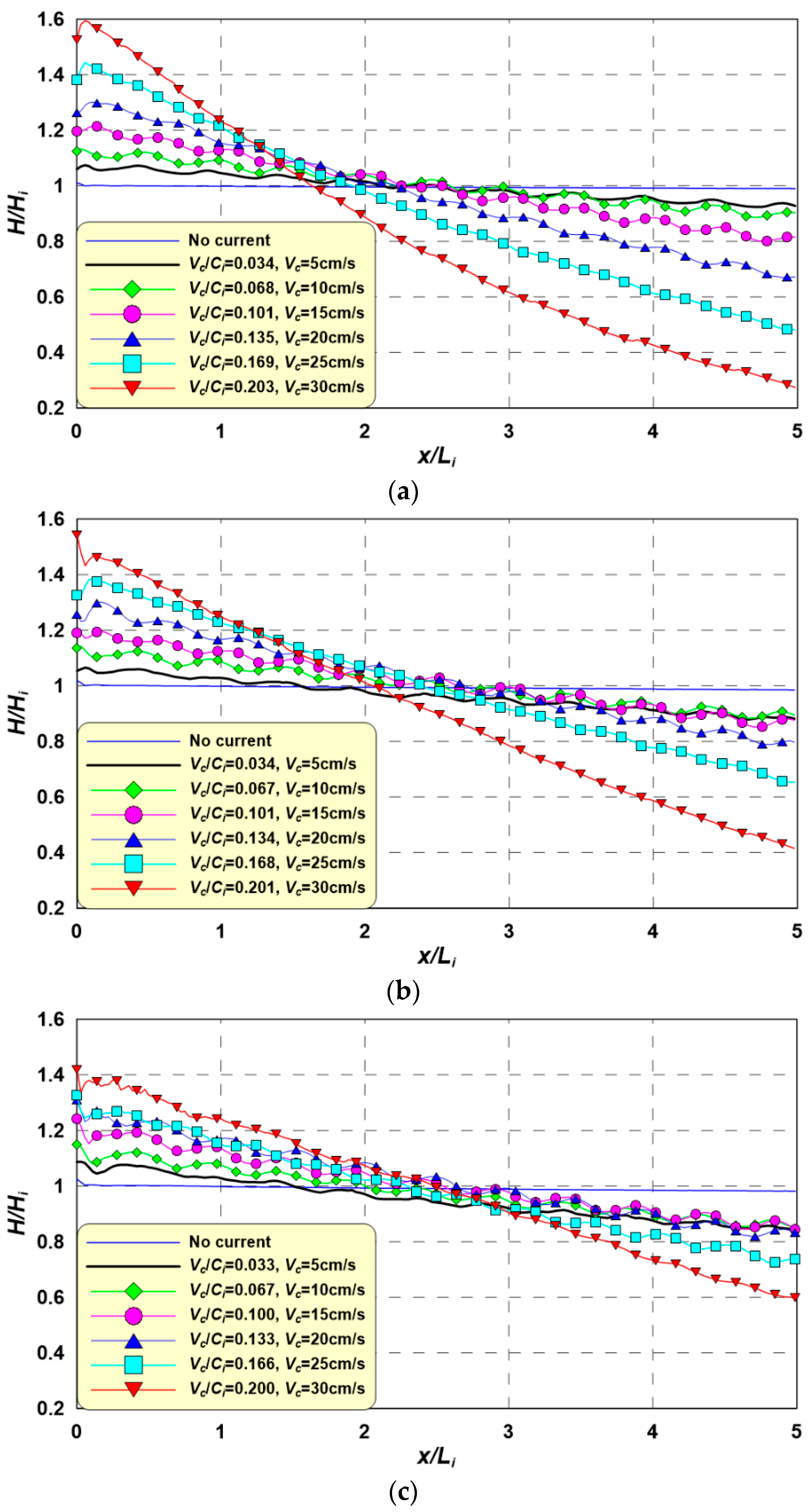
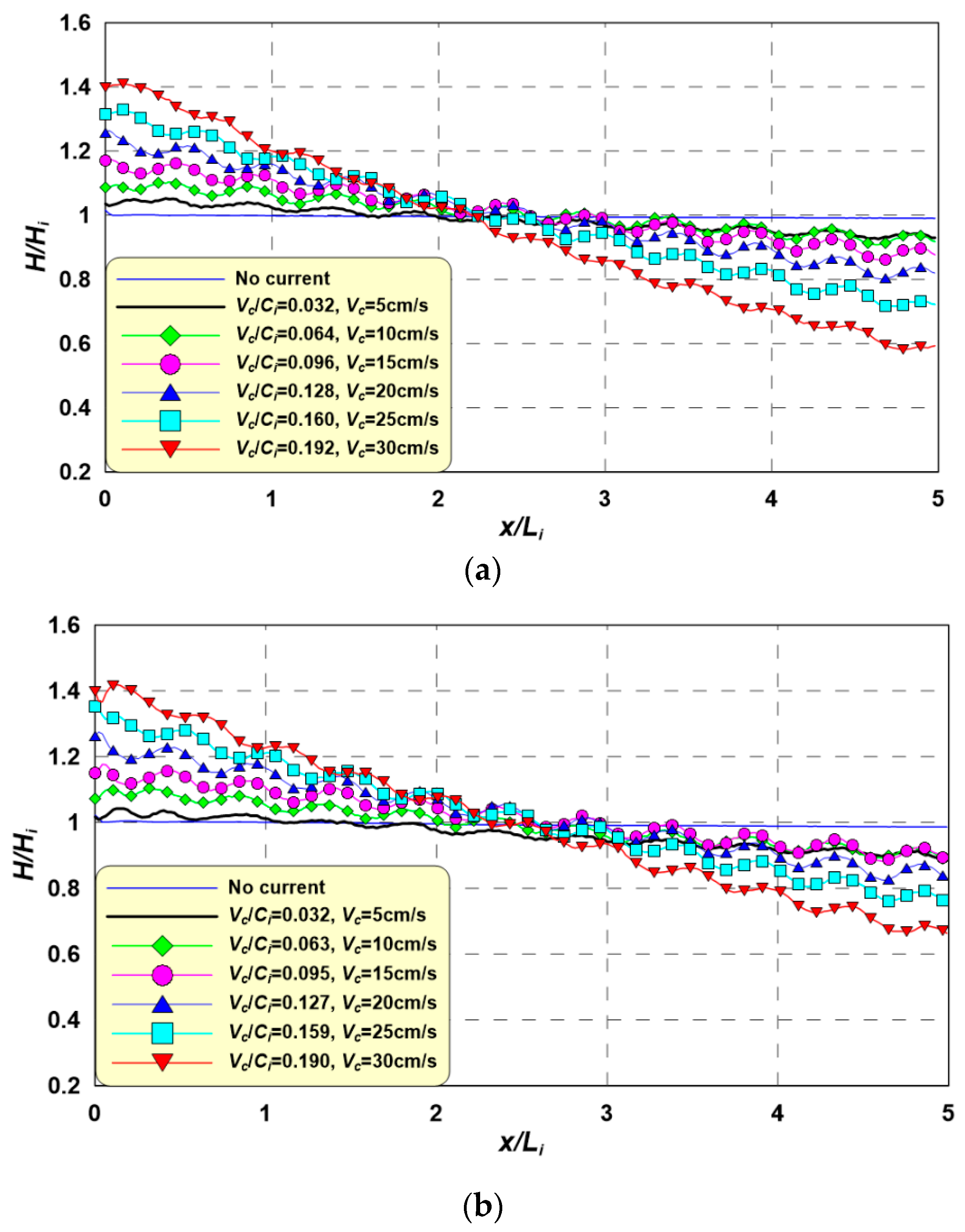
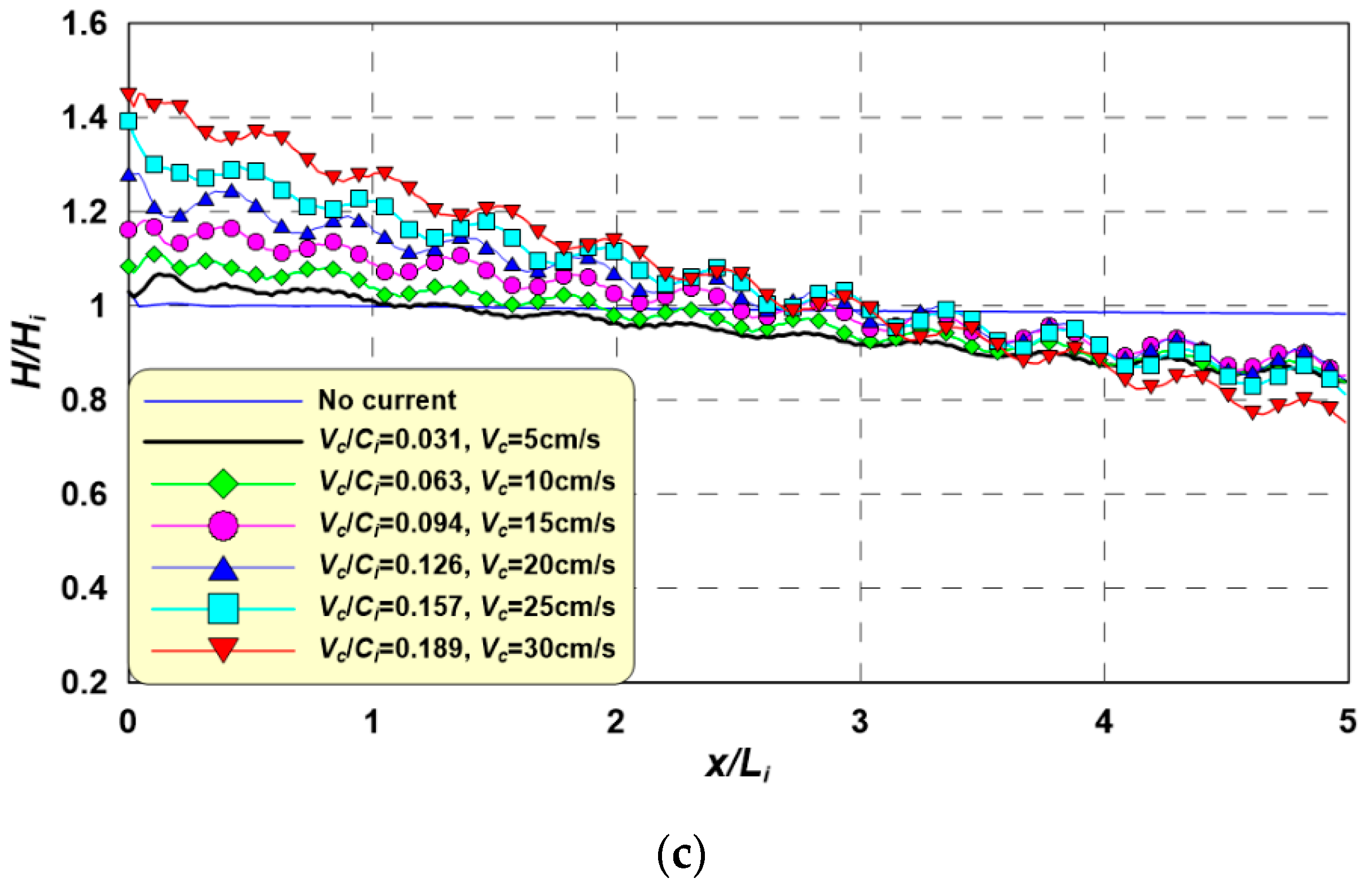
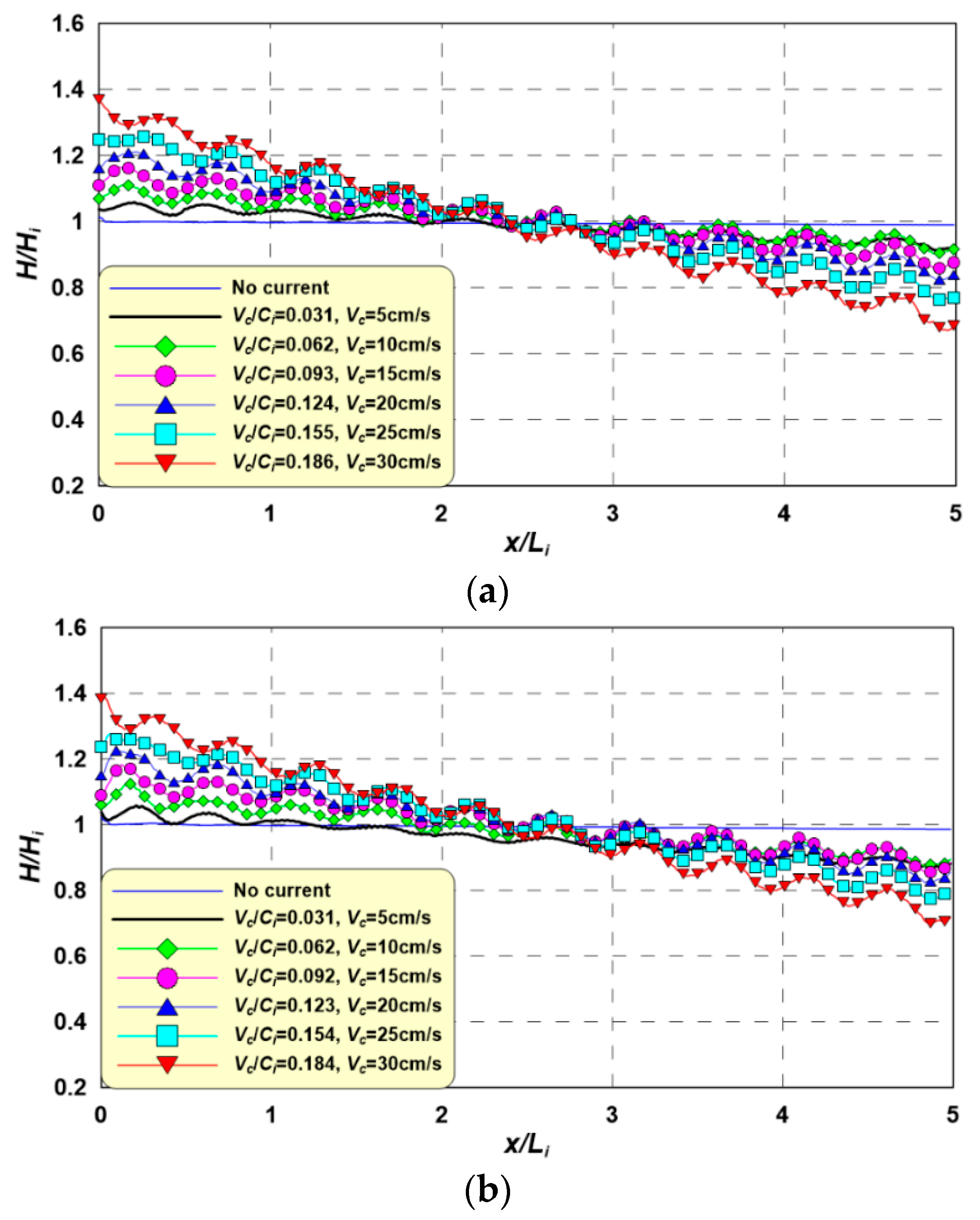
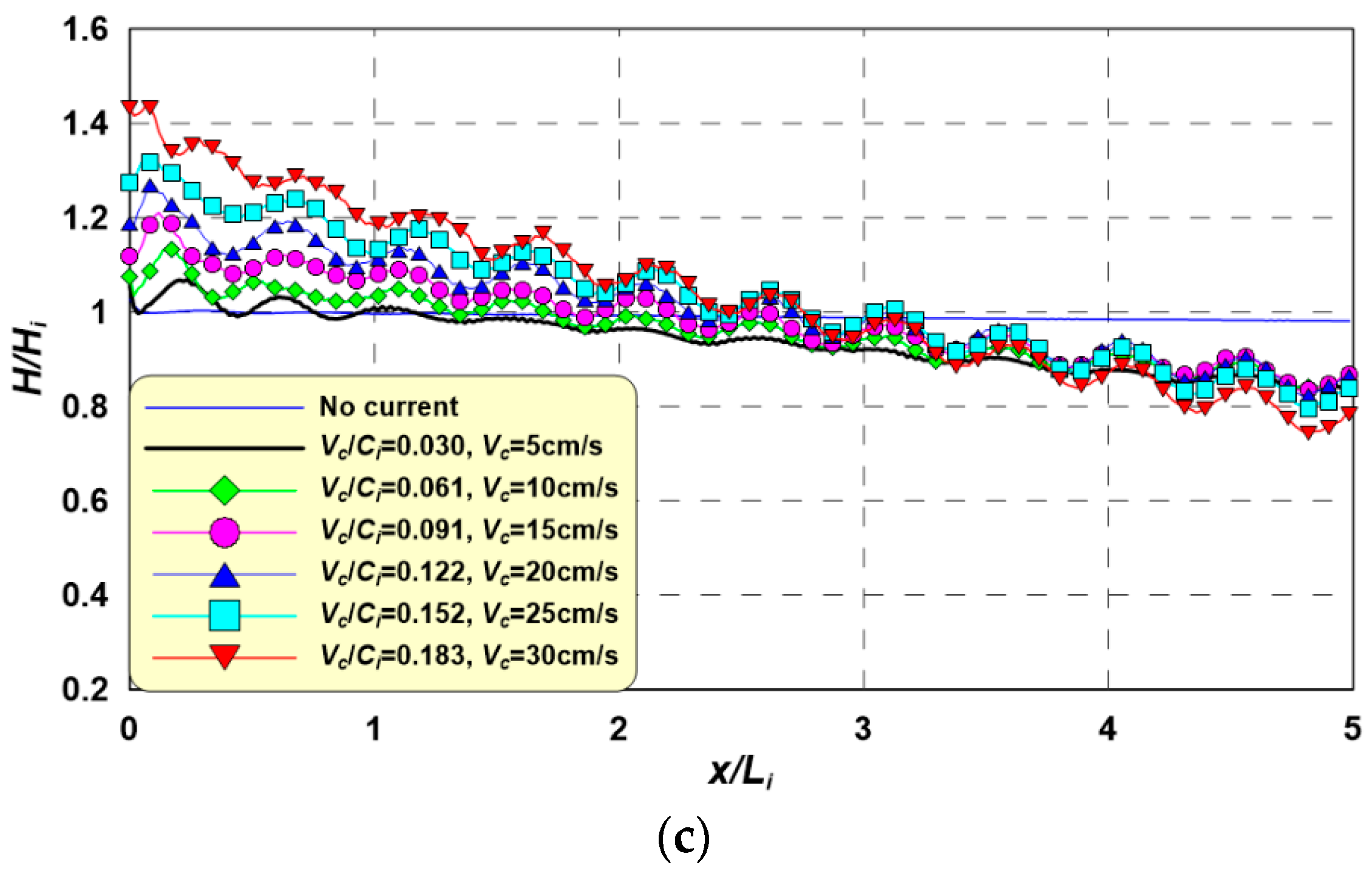
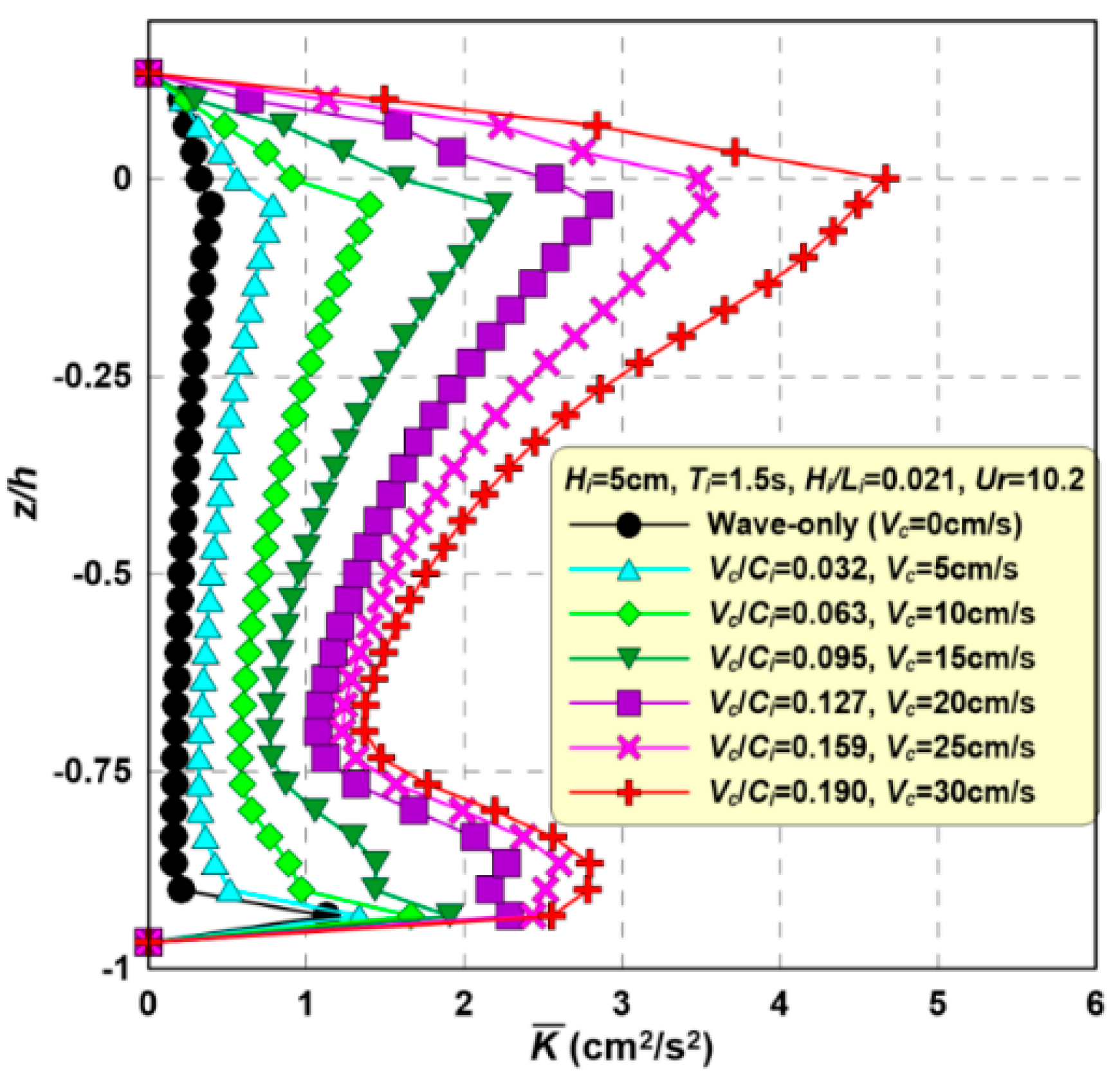
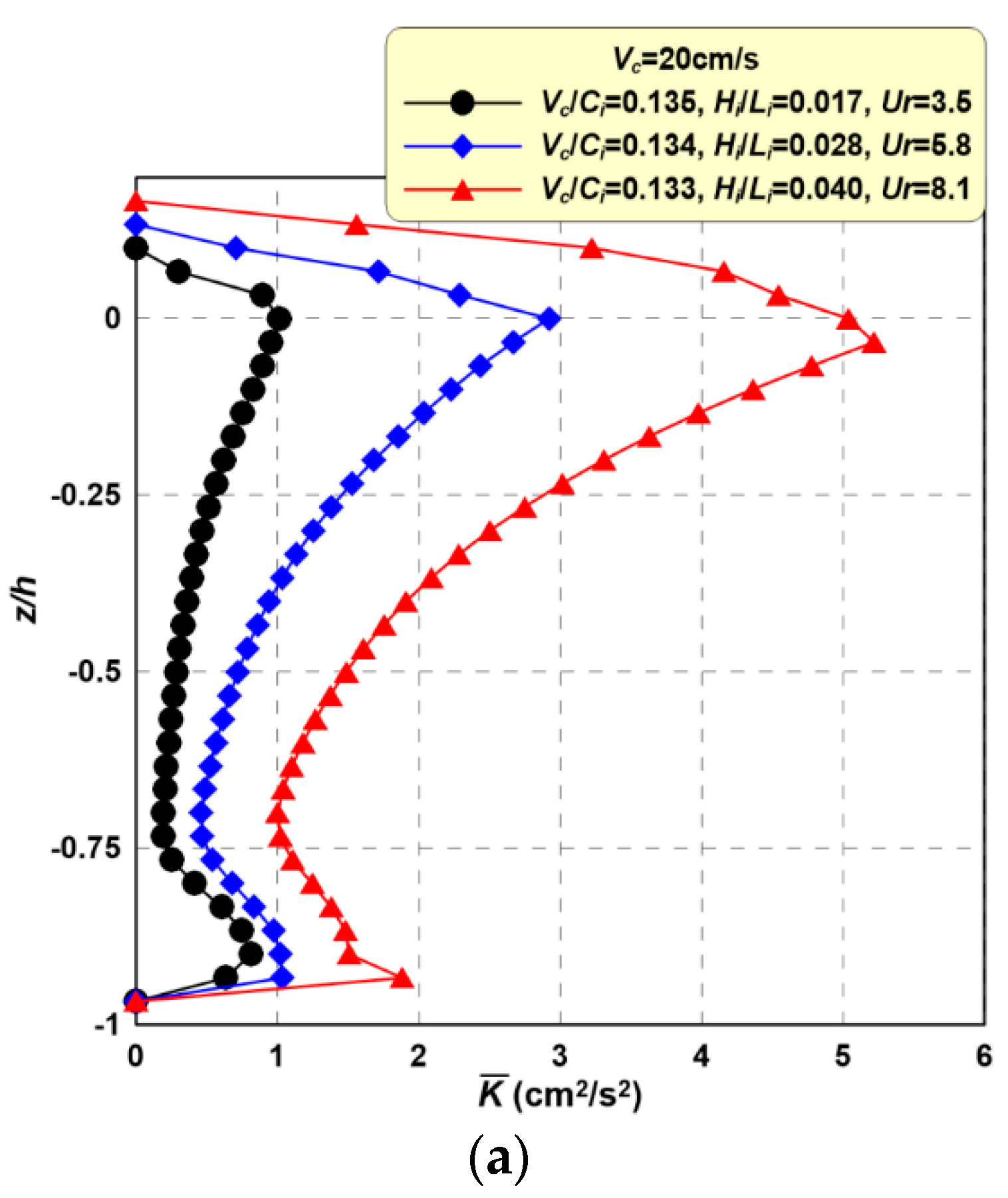

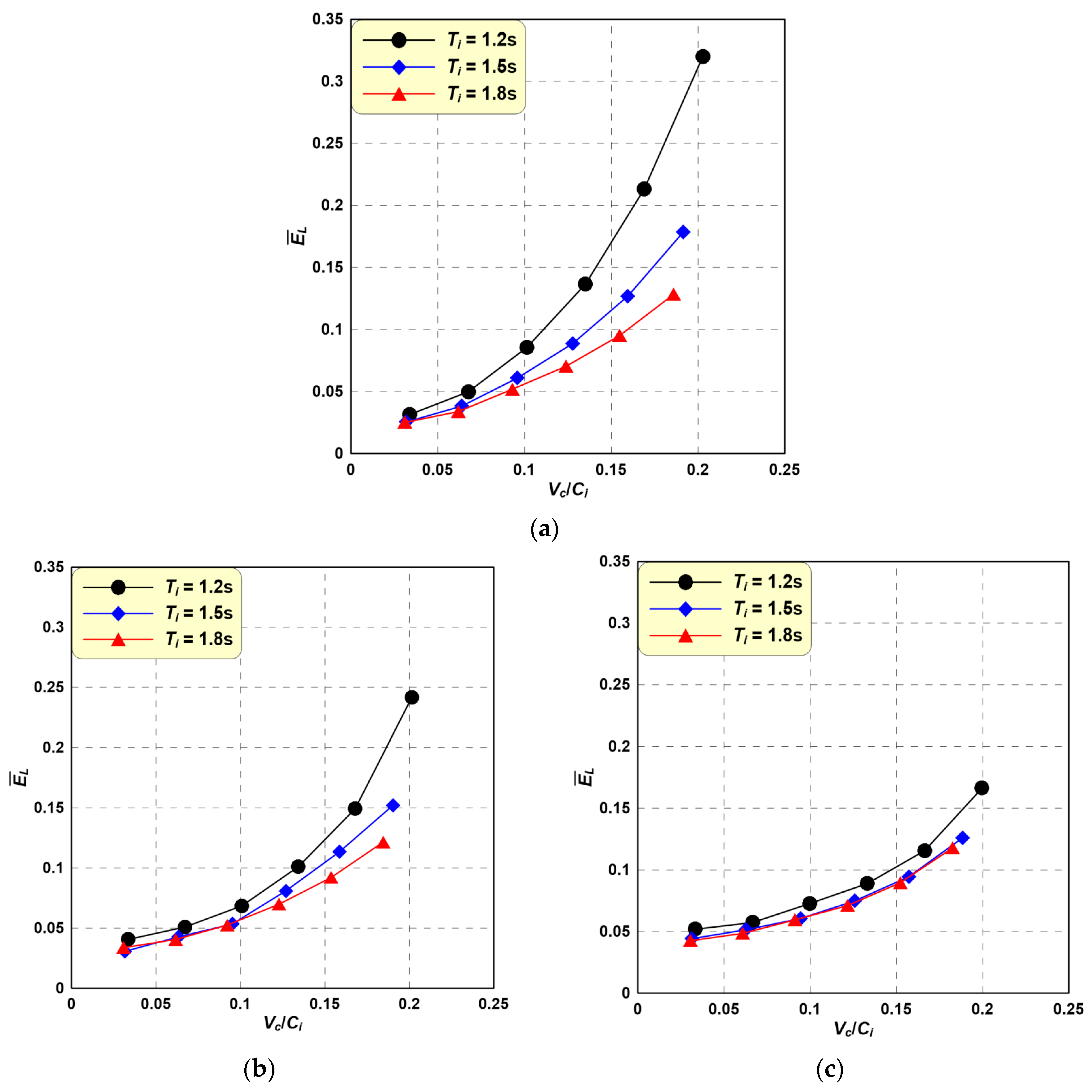
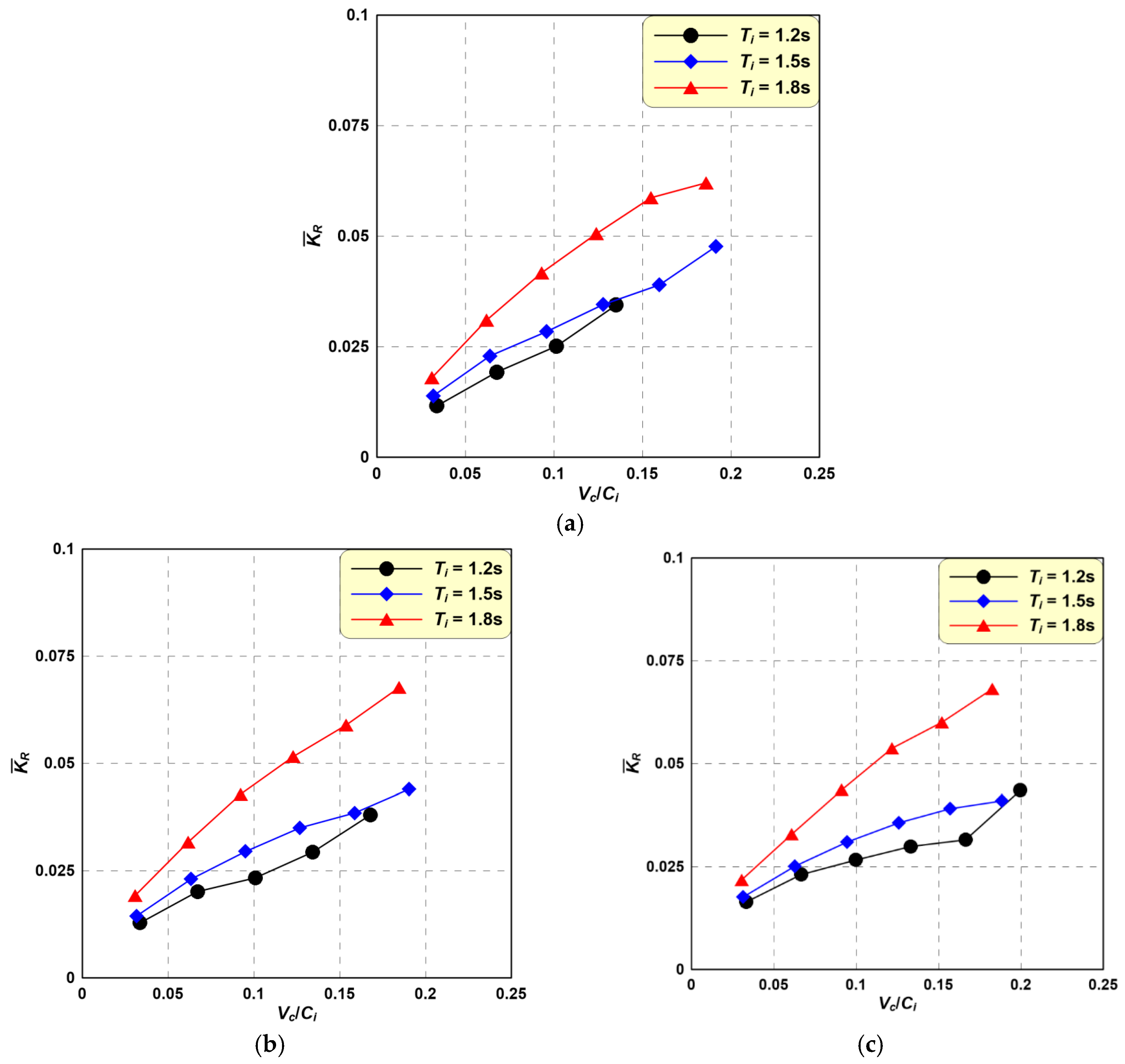

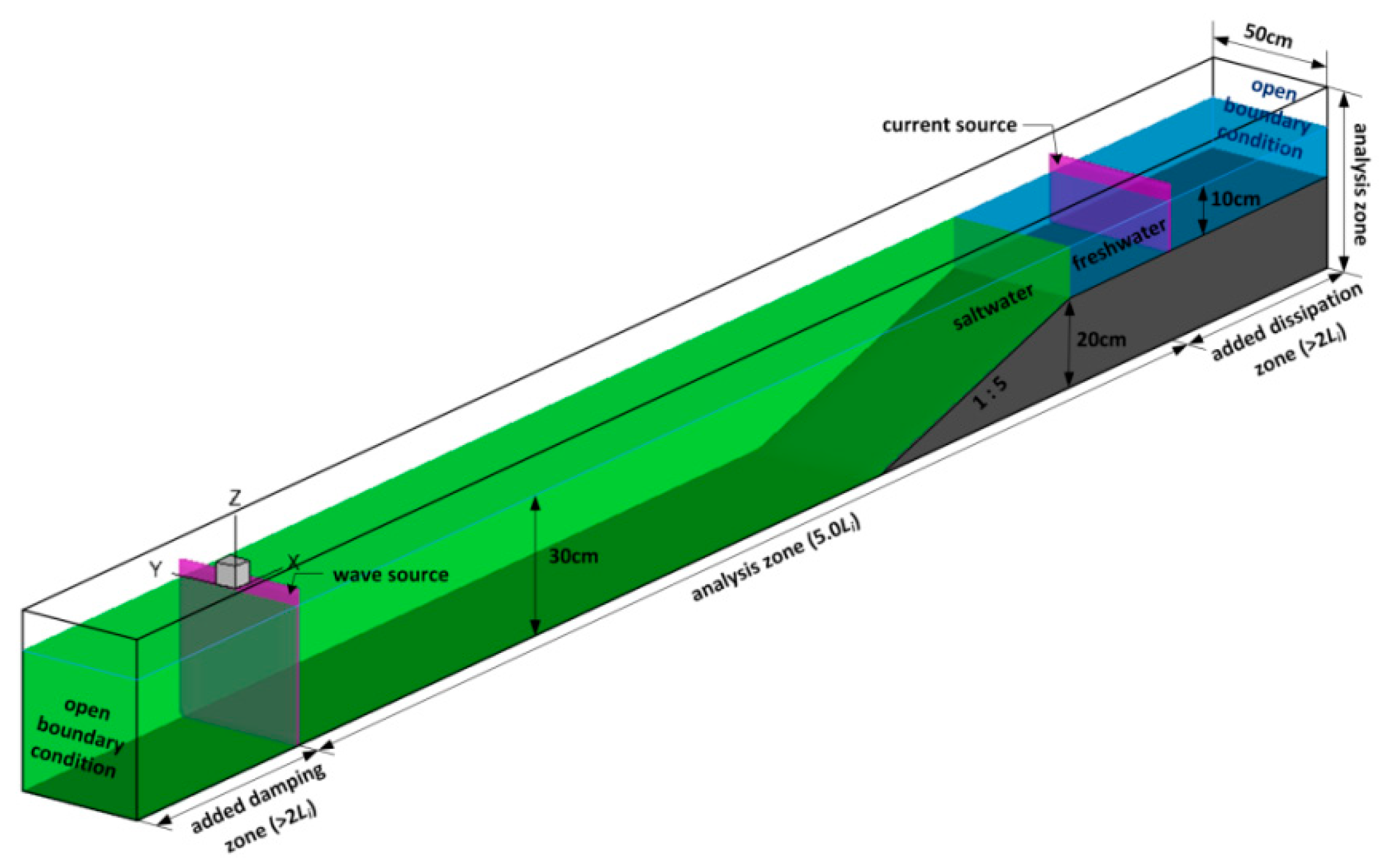
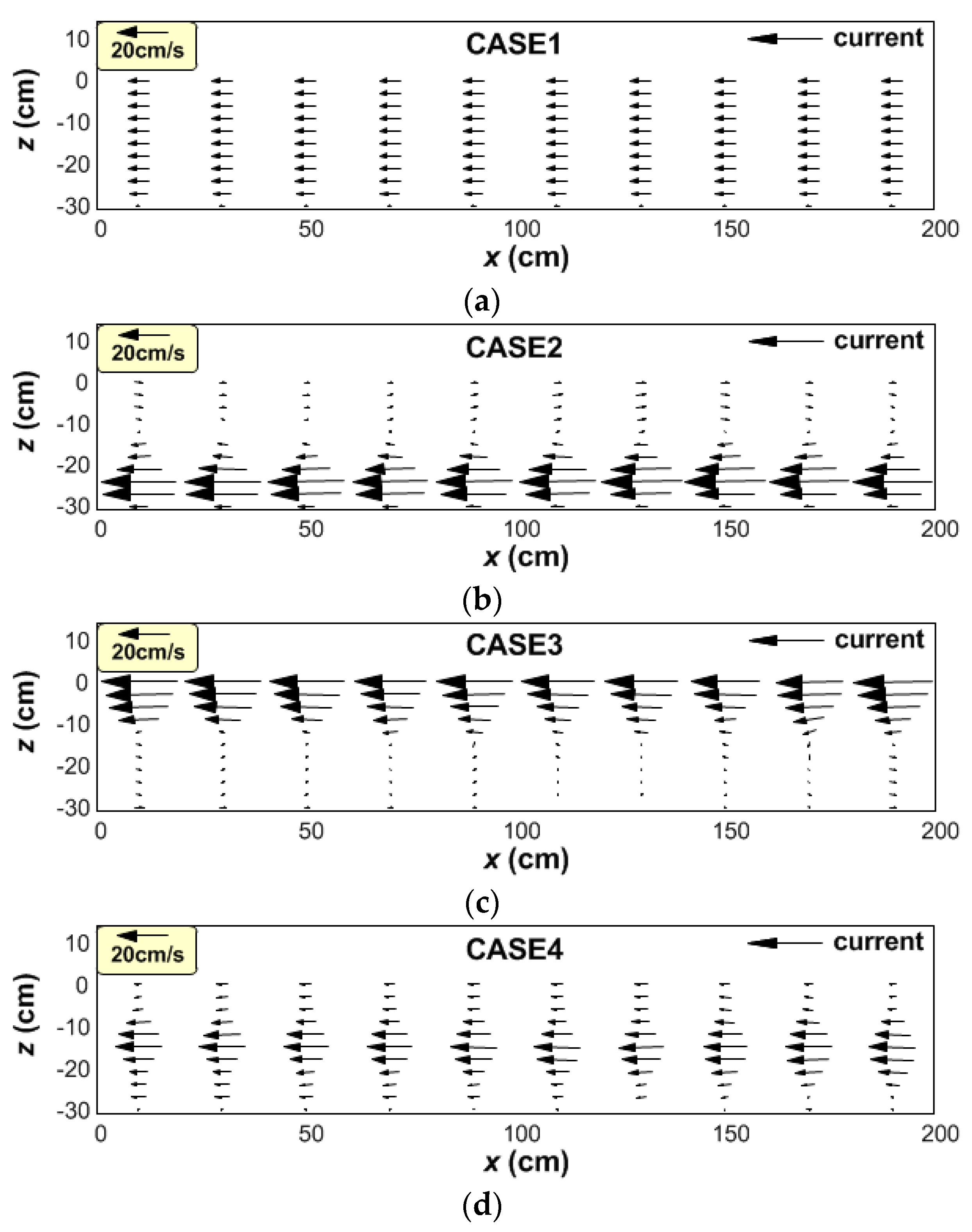
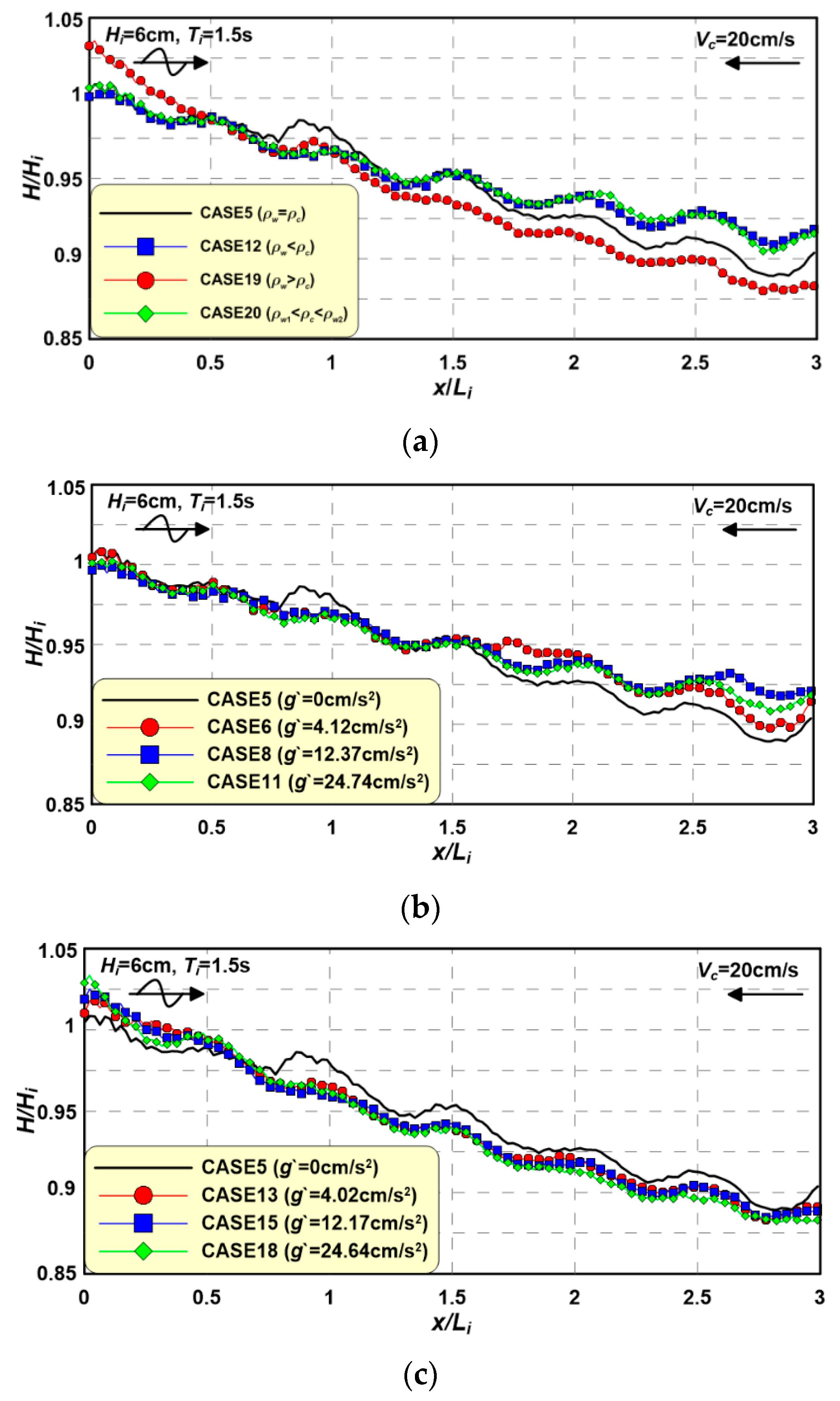
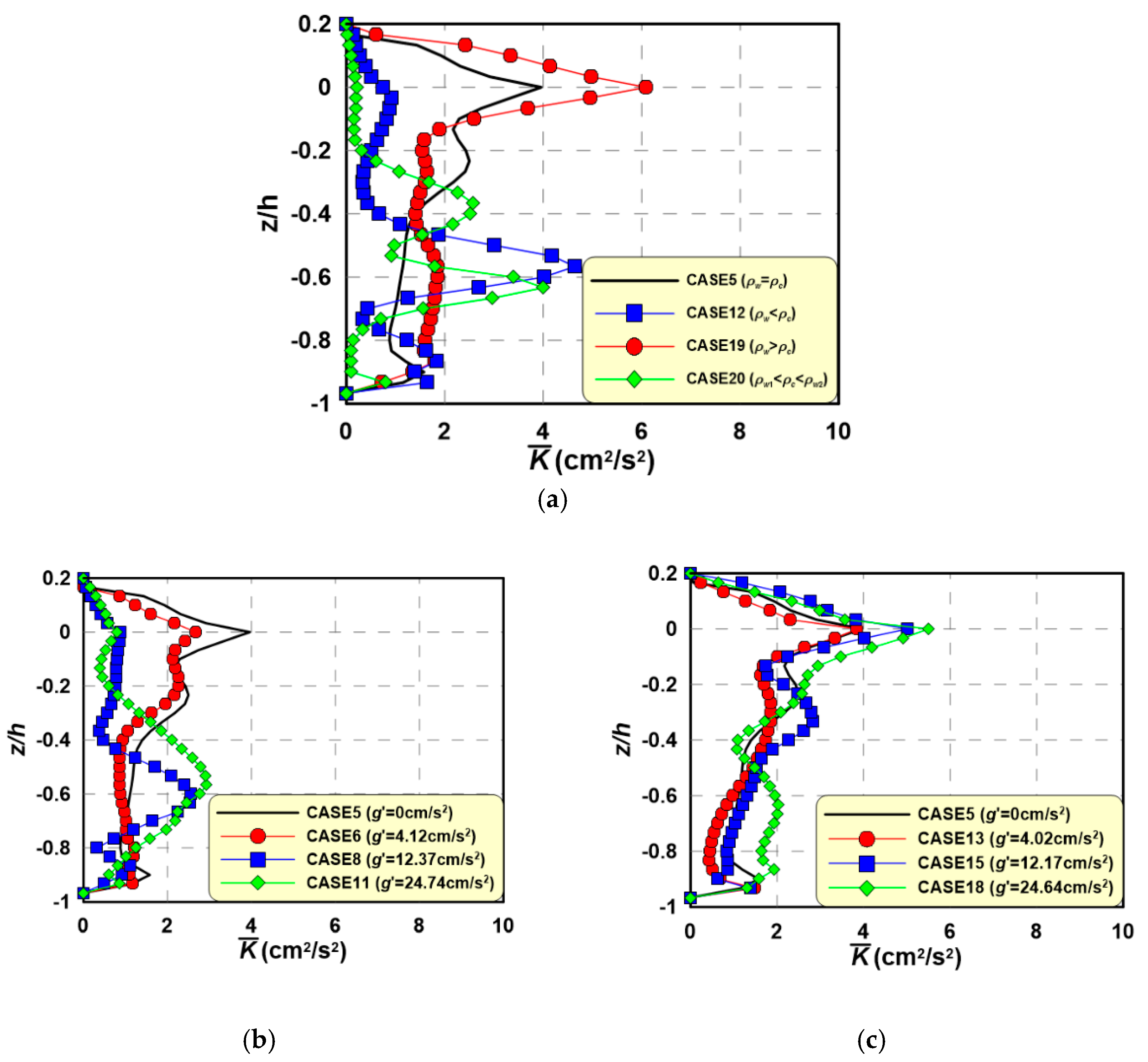
| CASE | Wave | Current | Reduced Gravity | |||||||
|---|---|---|---|---|---|---|---|---|---|---|
| Height | Period | Salinity | Density | Velocity | Salinity | Density | Δρg/ρmin | |||
| Hi (cm) | Ti (s) | Sw (psu) | ρw (g/cm3) | Vc (cm/s2) | Sc (psu) | ρc (g/cm3) | g’ (cm/s2) | |||
| Sw1 | Sw2 | ρw1 | ρw2 | |||||||
| 1 | - | - | 0 | 0.9982 | 20 | 0 | 0.9982 | 0 | ||
| 2 | 35 | 1.0276 | 28.86 | |||||||
| 3 | 35 | 1.0276 | 0 | 0.9982 | 28.86 | |||||
| 4 | 0 | 35 | 0.9982 | 1.0276 | 17.5 | 1.0129 | 14.33 | |||
| 5 | 6 | 1.5 | 0 | 0.9982 | 20 | 0 | 0.9982 | 0 | ||
| 6 | 6 | 1.5 | 0 | 0.9982 | 20 | 5 | 1.0024 | 4.12 | ||
| 7 | 10 | 1.0066 | 8.25 | |||||||
| 8 | 15 | 1.0108 | 12.37 | |||||||
| 9 | 20 | 1.0150 | 16.49 | |||||||
| 10 | 25 | 1.0192 | 20.62 | |||||||
| 11 | 30 | 1.0234 | 24.74 | |||||||
| 12 | 35 | 1.0276 | 28.86 | |||||||
| 13 | 6 | 1.5 | 35 | 1.0276 | 20 | 30 | 1.0234 | 4.02 | ||
| 14 | 25 | 1.0192 | 8.08 | |||||||
| 15 | 20 | 1.0150 | 12.17 | |||||||
| 16 | 15 | 1.0108 | 16.29 | |||||||
| 17 | 10 | 1.0066 | 20.45 | |||||||
| 18 | 5 | 1.0024 | 24.64 | |||||||
| 19 | 0 | 0.9982 | 28.86 | |||||||
| 20 | 6 | 1.5 | 0 | 35 | 0.9982 | 1.0276 | 20 | 17.5 | 1.0129 | 14.33 |
© 2020 by the authors. Licensee MDPI, Basel, Switzerland. This article is an open access article distributed under the terms and conditions of the Creative Commons Attribution (CC BY) license (http://creativecommons.org/licenses/by/4.0/).
Share and Cite
Lee, W.-D.; Mizutani, N.; Hur, D.-S. 2-D Characteristics of Wave Deformation Due to Wave-Current Interactions with Density Currents in an Estuary. Water 2020, 12, 183. https://doi.org/10.3390/w12010183
Lee W-D, Mizutani N, Hur D-S. 2-D Characteristics of Wave Deformation Due to Wave-Current Interactions with Density Currents in an Estuary. Water. 2020; 12(1):183. https://doi.org/10.3390/w12010183
Chicago/Turabian StyleLee, Woo-Dong, Norimi Mizutani, and Dong-Soo Hur. 2020. "2-D Characteristics of Wave Deformation Due to Wave-Current Interactions with Density Currents in an Estuary" Water 12, no. 1: 183. https://doi.org/10.3390/w12010183
APA StyleLee, W.-D., Mizutani, N., & Hur, D.-S. (2020). 2-D Characteristics of Wave Deformation Due to Wave-Current Interactions with Density Currents in an Estuary. Water, 12(1), 183. https://doi.org/10.3390/w12010183





